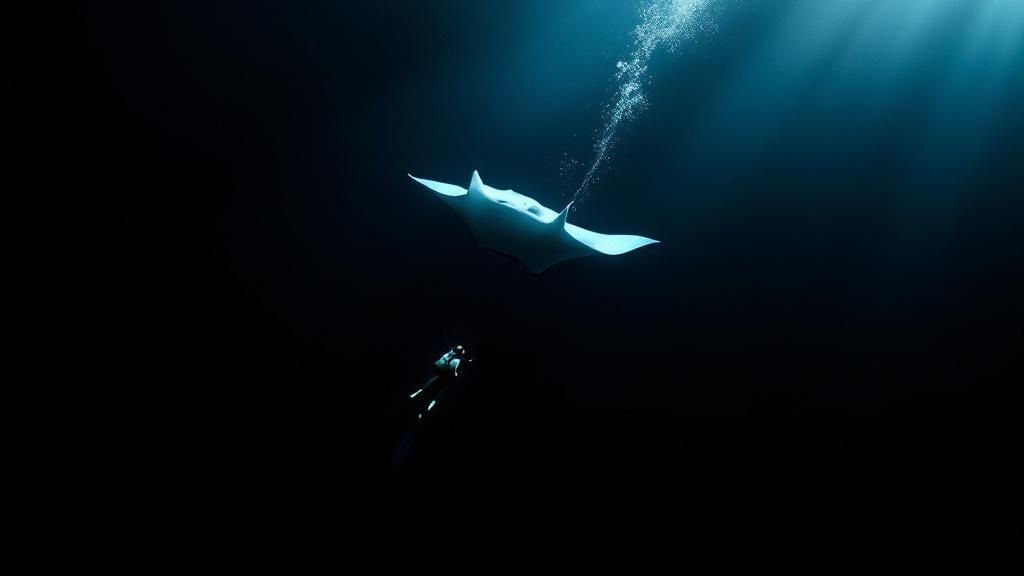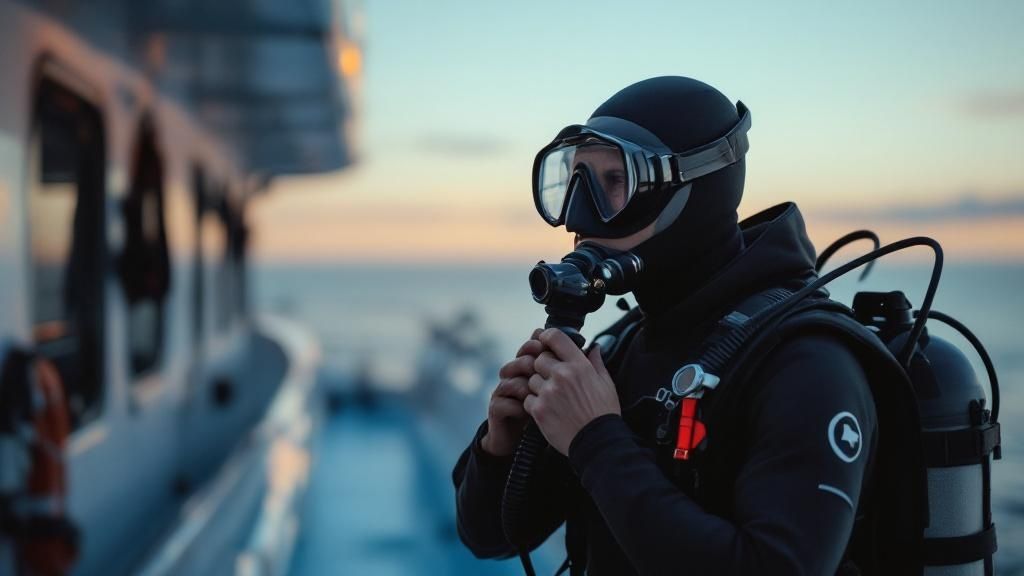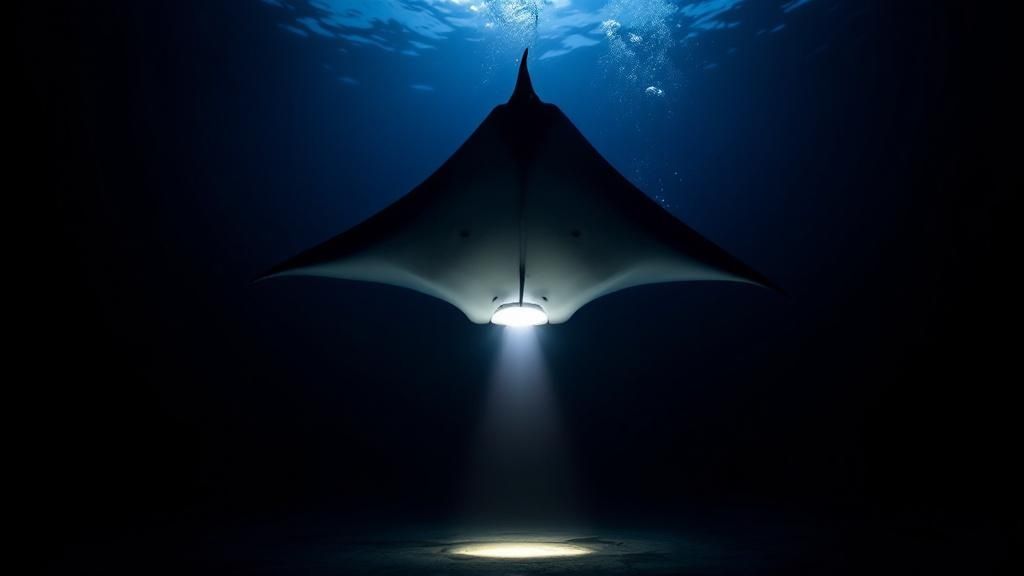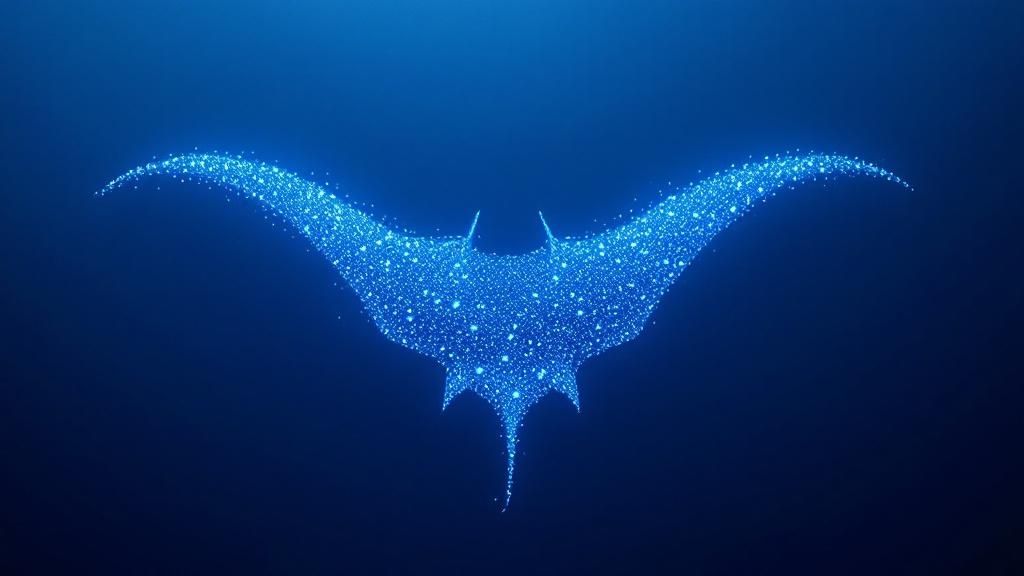Picture this: you're floating in the warm, dark Pacific Ocean. Suddenly, a giant, graceful creature with a wingspan wider than you are tall glides silently out of the abyss, swooping inches from your face in a mesmerizing underwater ballet. This is the heart of the world-famous Kona manta ray night dive.
It's a bucket-list adventure where you get a front-row seat to one of nature's most incredible spectacles. After sunset, tour boats head to specific coastal spots, well-known manta hangouts. The crew then sets up powerful lights in the water. For snorkelers, this is usually a large floating raft to hold onto. For divers, it's often a central light box on the seafloor, affectionately called "the campfire."
These lights are the key. They act like a giant beacon, attracting swarms of microscopic plankton, which happens to be the manta rays' favorite meal. The result? Pure magic. Drawn by the all-you-can-eat buffet, the resident reef manta rays emerge from the darkness. They perform effortless barrel rolls and soaring glides through the light beams, their cavernous mouths wide open to filter the water. It’s an otherworldly performance you have to see to believe.
To get a better sense of the tour's logistics, you can find out more about what the manta ray night dive entails.

Snorkel vs Scuba: How to See the Kona Manta Rays
One of the fantastic things about this encounter is that almost anyone can do it. You don't have to be a certified scuba diver to get in on the action. Both snorkeling and diving offer unforgettable—but very different—perspectives on the feeding frenzy.
Deciding which one is right for you really comes down to your personal comfort in the water, whether you have a scuba certification, and the type of view you're hoping for. To help you choose, here's a quick breakdown of what to expect from each experience.
| Aspect | Snorkeling Experience | Scuba Diving Experience |
|---|---|---|
| Viewpoint | Top-down view from the surface | Bottom-up view from the ocean floor |
| Certification | No certification required | Scuba certification required |
| Proximity | Mantas swim right up towards you | Mantas glide directly overhead |
| Best For | Families, kids, non-swimmers | Certified divers, photographers |
Here’s a little more detail on what that looks like:
-
Snorkeling: You'll be on the surface, holding onto a specially designed light board. From here, you get a stunning top-down view as the mantas swim directly up toward the light, often coming so close you could almost touch them (but don't!). It’s a great option for families, those who aren't certified divers, and anyone who wants a less gear-heavy adventure.
-
Scuba Diving: If you're a certified diver, you'll descend to the sandy bottom, usually around 35 feet deep. You’ll settle in near the "campfire" and look up as the massive mantas soar and dance above you, creating breathtaking silhouettes against the lights from the surface. It's an incredibly immersive view from below the main event.
No matter which you choose, the core experience is the same: witnessing one of nature's most awe-inspiring displays. Whether you're watching from the surface or the seafloor, you're in for an unforgettable night with Kona's gentle giants.
Why Kona Is the Manta Ray Capital of the World

So, what makes this one little stretch of coastline on the Big Island the undisputed champion for manta ray encounters? It’s not just a lucky break. It’s a perfect combination of geography, biology, and a fascinating bit of local history. While many wildlife experiences are seasonal gambles, the manta ray dive in Kona is a year-round certainty, all thanks to a very special set of conditions.
Kona's coast is naturally protected from the open ocean, which creates calm, sheltered bays. These bays are the perfect dining rooms for manta rays. Ocean currents consistently deliver a reliable buffet of plankton—their favorite meal. Because the pantry is always full, the local mantas have no reason to leave. This has resulted in a large, permanent population that calls Kona home.
The story of how this became a world-famous dive is pretty amazing. It all started decades ago when the Kona Surf Hotel began shining lights into the water at night. The lights attracted swarms of plankton, and it didn't take long for the mantas to show up for the easy meal. Clever local divers quickly picked up on this, and from that simple observation, an entire industry was born.
The Two Premier Manta Dive Sites
What began with one hotel has since evolved into the well-organized, eco-conscious operation we see today, now focused on two main locations. Both spots offer incredible opportunities to see mantas, but they each have a slightly different vibe. Understanding the nuances can help you pick the perfect tour for your skill and comfort level.
Each site—Manta Village and Manta Heaven—has its own unique personality, defined by things like depth, conditions, and how many mantas you're likely to see.
Manta Village: The Original Site
Manta Village, nestled in Keauhou Bay just south of Kailua-Kona, is the original hotspot. This is where it all began, right in front of that old hotel.
- Ideal for Beginners: This site is fairly shallow and protected, with a sandy bottom and calm water. That makes it a fantastic choice for first-time night divers, snorkelers, and even families with kids.
- Reliable Sightings: The success rate here is phenomenal. Operators report seeing mantas on over 90% of their trips.
- Close and Personal: Because it's shallower, snorkelers floating on the surface often get just as good a show as the scuba divers settled on the seafloor.
Manta Heaven: A Deeper Dive
A bit further north, up by the Kona International Airport, you’ll find the second site: Manta Heaven. Sometimes called Garden Eel Cove, this spot offers a slightly different, and at times more dramatic, spectacle.
- For the Experienced Diver: Manta Heaven is a deeper dive. This often appeals more to certified divers and underwater photographers who want to capture some truly unique shots from different angles.
- Potential for More Mantas: While sightings are just as consistent as at Manta Village, this location is known for occasionally attracting bigger groups of rays. It’s not unusual to be surrounded by a dozen or more mantas swirling through the lights.
- Different Topography: The underwater scenery here is different, offering a distinct and beautiful backdrop for the whole experience.
Choosing between these two legendary sites is half the fun. You can learn more about why you should go on a manta ray dive in Kona to help you get ready for an adventure you’ll never forget.
How to Prepare for Your Manta Ray Adventure
You’ve booked your manta ray dive in Kona—fantastic! That's the first step to an incredible experience. But to make sure your night is truly magical, a little bit of prep work on your end makes all the difference. Knowing what to bring and how to pick the right guide will set you up for a smooth, unforgettable encounter with these gentle giants.
The most critical choice you'll make is your tour operator. They aren't all the same, and your decision directly affects the well-being of the mantas. Always look for companies that are Manta Ray Green List certified or at least publicly follow its guidelines. This isn't just a fancy label; it's a commitment to sustainable, ethical tourism.
By choosing a certified operator, you're actively supporting the long-term health of Kona’s manta population. These guidelines were specifically created to protect the mantas by minimizing human impact, and your choice makes you part of the solution.
Choosing Your Guide
A top-notch operator puts safety and education first. Before you even touch the water, their crew will give you a detailed safety briefing. Don't tune this out! This is vital information on how to act in the water to keep both yourself and the mantas safe and comfortable. How they handle this briefing often tells you everything you need to know about the quality of the tour.
What to Pack for Your Trip
Your tour company will handle all the essential dive or snorkel gear, but you’ll want a small bag with some personal items to stay comfortable. Think of it as packing for a cool evening out on the water, because that's exactly what it is.
Your Personal Checklist:
- A Towel: This seems obvious, but you'd be surprised how many people forget. You’ll be very happy to have it when you get back on the boat.
- Dry Clothes or a Warm Jacket: Even on a balmy Hawaiian evening, the wind on the boat ride back can feel surprisingly chilly once you're wet. A sweatshirt or windbreaker is a game-changer.
- Reef-Safe Sunscreen: For sunset tours, make sure to apply it well before you leave the shore.
- Reusable Water Bottle: Hydration is key, especially after being in saltwater.
- Camera: An underwater camera like a GoPro is perfect. Just make sure you're familiar with its low-light settings before you get in the water.
Being properly prepared is a huge part of any successful outing. For some broader advice on choosing the right water sports equipment, this external guide has some great tips that might help.
Managing Expectations and Seasickness
It’s crucial to remember these are wild animals in their natural habitat. The manta ray dive in Kona boasts an incredible success rate, often over 90%, but a sighting is never guaranteed. The good news? Most reputable companies offer a "manta guarantee." If no mantas show up, you can re-book for free on another night. That's why I always tell people to schedule their dive early in their trip—it gives you a buffer for that second chance, just in case.
Finally, a quick word on motion sickness. If you're even slightly prone to it, take precautions. The boat ride is usually pretty calm, but why risk it? An over-the-counter remedy taken an hour or so before departure can be the difference between a good night and a truly great one.
Understanding the Gentle Giants You Will Meet

The incredible show you’re about to see on the Kona manta ray night dive isn’t just a happy accident. It’s a beautifully simple—and brilliant—display of animal behavior that dive operators have come to understand perfectly. The whole thing works by creating a giant, glowing, all-you-can-eat buffet for the local manta rays.
Think about it from the manta's perspective. Your main food source is microscopic plankton, which is usually spread out all over the ocean. Then, suddenly, a powerful light cuts through the darkness. This light is a magnet for plankton, drawing them in and concentrating them into a thick, soupy cloud. For a manta ray, finding this is like stumbling upon a five-star restaurant that just opened up, offering an effortless feast.
That, in a nutshell, is the science behind the underwater ballet you're here for.
More Than Just a Show
What makes the manta ray dive kona experience so special is that it’s more than just watching animals feed. You’re actually stepping into the middle of a living, breathing scientific project. Every single manta ray has a unique pattern of black spots on its white belly, almost like a human fingerprint. This allows dive guides and researchers to identify, name, and track each ray over its entire lifetime.
So, when you're down there, you’re not just looking at a manta ray. You might be meeting a specific individual who has been known and followed for years, one with a distinct personality and a story all its own.
This isn't just for fun, either. It’s the backbone of critical conservation work. By identifying individual rays, scientists can track the population's health, understand their movements, and learn about their life cycles. It’s what helps ensure this amazing encounter will be around for future generations to experience.
Meet the Local Celebrities
This long-running identification project has turned many of Kona's rays into local celebrities. Your dive guide will likely point out well-known mantas by name, sharing stories about their quirks or history. You could meet a ray known for being extra curious, a huge female they call “Big Bertha,” or one with a tell-tale scar from a close call.
This research has made Kona’s manta population one of the most studied on the planet. The practice of using belly spots for identification kicked off back in 1991, with the very first named manta, "Lefty." Today, the catalog has swelled to over 290 recognized individuals. This gives scientists a treasure trove of data on population dynamics and health. You can learn more about how they track Kona’s famous manta rays on scistarter.org.
Knowing the names and backstories of these gentle giants adds a whole new dimension to the dive. It creates a real connection, turning an incredible spectacle into a personal introduction to the animals that call these waters home.
How to Be a Responsible Manta Ray Viewer
https://www.youtube.com/embed/yhtx3b5X3oc
The Kona manta ray night dive is one of the most reliable wildlife encounters on the planet, and that’s no accident. It’s built on a foundation of deep, mutual respect between us and the mantas. To keep this experience magical for everyone—especially the rays—you need to see yourself as a guest in their underwater dining room. This teamwork is what makes the whole thing safe, ethical, and sustainable for years to come.
Think of it this way: you're getting a front-row seat to a spectacular natural theater. The golden rule is passive interaction. Your only job is to watch the incredible show unfold without getting involved. These are wild animals, and our goal is to enjoy their presence without changing their natural behavior one bit.
Why You Must Never Touch a Manta Ray
This is the most critical rule of the entire dive: resist the urge to touch the mantas. I know it's tempting. They glide so close you could easily reach out, but touching them can cause serious, lasting harm.
A manta ray's skin is covered in a thin, protective mucus coating—a lot like the slime layer on other fish. This layer is their first and best line of defense against nasty bacteria and skin infections. When you touch them, you're literally wiping away this vital protective film, leaving them vulnerable to all sorts of diseases. It’s like taking away their shield. By simply keeping your hands to yourself, you are playing an active role in protecting their health.
"Observe only: No touching. This is the cornerstone of responsible manta interaction. Your respect for their space ensures that the Kona manta ray population remains healthy and trusts divers and snorkelers, continuing this amazing encounter for future generations."
The Dos and Don'ts of Your Dive
Your divemaster will give you a detailed briefing before you hit the water, but it helps to have these guidelines in your back pocket. Following them is what makes for a successful and respectful dive for everyone.
Essential Rules for Your Time in the Water:
- DO stay in your assigned spot. If you’re diving, that means staying low on the sandy bottom. If you’re snorkeling, you’ll be holding onto the light board at the surface.
- DON'T chase the mantas. Seriously, don't. Let them come to you. Chasing them stresses the animals out and will likely make them leave the area entirely.
- DO keep your hands and arms crossed or held close to your body. This is the best way to prevent accidentally bumping one of these gentle giants as they glide by.
- DON'T dive down from the surface if you're snorkeling. That open water column is the mantas' "dance floor," and we need to keep it clear so they have plenty of room to maneuver safely.
Following these simple rules elevates you from just another tourist to a true guardian of this world-class experience. Your actions directly contribute to the conservation of Kona’s beloved manta rays.
Insider Tips for Photographers and Avid Divers

Okay, so you've done the dive, felt the magic, and now you're completely hooked. For a lot of us, one manta ray dive in Kona is never enough. It's just the start. Whether you're a photographer chasing that one perfect shot or a passionate diver looking to connect on a deeper level, there are ways to make your next trip even more incredible.
For photographers, shooting in the dark is a classic challenge, but the payoff is huge. The key is knowing your gear before you hit the water. This is not the time to be fumbling with auto mode. Manual settings are your absolute best friend down there.
Think of it like trying to photograph the Milky Way—you need to open your camera up and let in as much light as possible. Start with a wide aperture (think f/2.8 or lower if your lens allows) and crank up your ISO a bit. A range of 1600-3200 is a good place to begin. From there, you can play with your shutter speed, but just be careful to avoid motion blur from you or the mantas.
Mastering Your Camera and Position
I see this all the time: divers using their camera's built-in flash. It’s the fastest way to ruin a shot. All it does is light up the thousands of tiny plankton right in front of your lens, creating a "snowstorm" effect that photographers call backscatter. It’s a mess.
Instead, let the powerful lights from the dive operators do the heavy lifting for you.
- Get Low and Shoot Up: The absolute best angle is from the sandy bottom, looking up. This lets you use the central "campfire" of light to beautifully silhouette the mantas as they glide overhead against the dark ocean.
- Use External Strobes: If you're serious about your shots and have external strobes, point them outward, away from the camera. This illuminates the manta’s white belly from the side, giving you a brilliant, detailed subject without that ugly backscatter.
- Bring a Wide-Angle Lens: These animals are huge. A wide-angle lens is non-negotiable if you want to capture their entire wingspan, especially when they're passing just inches above your head.
Becoming a Manta Naturalist
Once you’ve done this a few times, the dive changes. It stops being just a spectacle and starts feeling more like a scientific observation. This is your chance to learn the names and personalities of Kona's resident manta population. Believe it or not, each ray can be identified by the unique spot pattern on its belly, which is as distinct as a human fingerprint.
It's a game-changer when you can recognize a specific manta, like the local legend "Lefty." You're not just watching a manta ray anymore; you're reuniting with an individual whose life you're now a small part of.
This deeper connection is built on decades of incredible research. The sighting data collected over the years at Manta Village and Manta Heaven has revealed so much about their travel patterns, seasonal habits, and the overall health of the population. To get a better sense of this, you can explore the fascinating manta ray statistics on MantaRayAdvocates.com.
Ultimately, digging a little deeper transforms your manta ray dive kona experience. It becomes a personal journey into a world of photography, discovery, and conservation.
Your Manta Ray Dive Questions, Answered
As you get closer to booking your trip, a few questions always seem to pop up. It's completely normal! Having all the details sorted out beforehand is the best way to feel relaxed and ready for the adventure ahead. Here are some answers to the things we get asked most often.
What’s the Best Time of Year to Go?
This is one of the best parts about the Kona experience: you can see manta rays any time of year. Our local population sticks around all 12 months, so there’s no "off-season." They're always here and ready to feed.
That said, if you're looking for the absolute calmest water, the summer months from May to September usually offer the flattest, most glass-like conditions. But no matter when you come, the mantas will be waiting.
Is This Experience Safe for Kids?
Yes, absolutely. The snorkel version of this tour is fantastic for families and is even a great fit for kids and non-swimmers. No one is expected to swim around on their own.
Instead, you’ll hold onto a large, custom-made light board that floats on the surface. The powerful lights on the board are what draw in the plankton, so all you have to do is hold on, float, and enjoy the incredible ballet unfolding right below you.
Reputable operators will always provide top-notch flotation gear (like wetsuits) and have professional guides in the water with you the entire time, making sure everyone feels safe and has a great experience.
How Much Does the Manta Ray Dive Cost?
Prices will shift a bit depending on the company you choose, but you can generally plan on these price ranges:
- Snorkeling Tours: Usually between $100 to $175 per person.
- Certified Scuba Dives: Typically from $125 to $200 per person.
This fee almost always covers everything you need—the wetsuit, mask, fins, snorkel, or full scuba setup, plus the boat ride and the expertise of the crew. For an even deeper dive into what to expect, check out our guide on what you should know about the manta ray dive in Kona before you finalize your plans.
What Happens if We Don’t See Any Mantas?
It’s a valid question—these are wild animals, after all, not performers in an aquarium. While sightings are incredibly consistent (most operators boast a success rate over 90%), nature is never a 100% guarantee.
On the very rare night the mantas don't show up, nearly every company has a "manta guarantee." This typically means they’ll let you come back and try again on another night for free, based on availability.
Ready to witness the magic for yourself? The crew at Kona Honu Divers has years of experience and is excited to guide you on this truly unforgettable adventure. Book your tour today!
